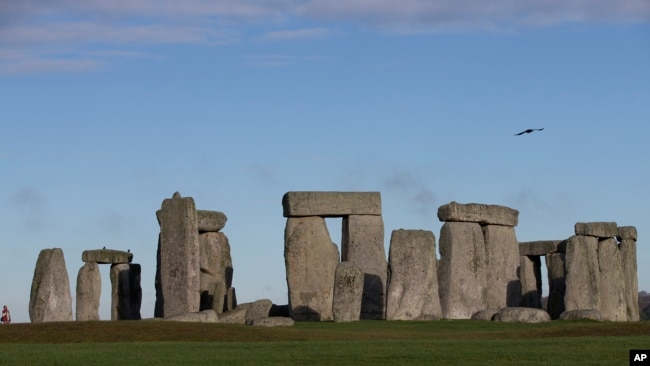時代と共にその意味合いの変遷が展示されているそうです。
コロナが収束したら訪れてみたいです!!
早速VOAを聴いてみましょう!!
ロンドンの大英博物館で、イングランド南部にある有名な古代の石の輪、ストーンヘンジの謎に迫る新しいショーが開催されました。
この巨大な石は、5,000年から3,500年前に設置されたと考えられています。この円環の目的については、いまだに議論が続いています。ストーンヘンジは、太陽盤として、埋葬地として、記念碑として、あるいはそれ以外の意味を持っていたのでしょうか?
ニール・ウィルキン氏は、The World of Stonehengeという番組の主任学芸員です。「私たちは皆、ストーンヘンジを知っていると感じています」と彼は言います。「小学生の時に訪れたり、子供を連れて見に行ったりしています。しかし、しばしば私たちはその世界、記念碑を建てた人々、記念碑に礼拝に来た人々について、あまり知らない、知らないように感じることが多いのです。」
ストーンヘンジの世界展では、ヨーロッパ各地から集められた430点以上の品々から、この遺跡を作った人々やその世界について探求します。当時は、技術の発展、大移動、社会の変化などが見られた激動の時代でした。
ウェールズから250キロメートル移動した石でストーンヘンジの最初の部分を建設した人々の後に、青銅器時代の農民、商人、ヨーロッパ大陸とつながっていた戦士が続きました。
当初、ストーンヘンジは墓地でした。200人もの男性、女性、子供の焼かれた遺骨が保管されています。
ウィルキン氏は「よく、ピラミッドと同じようなものかと聞かれます。でも、このモニュメントの真ん中にはファラオはいないんです。」と言います。
その後、最初の青石は、その上部にはまぐさがかけられて高さ4メートルの立石の輪の中に置かれていました。その多くは今も残っています。このモニュメントは先祖を敬い、儀式を行う場所となった、とウィルキン氏は言います。
この展示会で最初に目にするのは、ストーンヘンジを模した古代のカップです。
「これは先史時代のお土産のようなものです」と、プロジェクト・キュレーターのジェニファー・ウェクスラー氏は言います。
他にも、新石器時代の石切り工具で覆われた壁や、精巧に作られた金の帽子や宝石など、興味深い画像が多数展示されています。
ストーンヘンジは、古代英国で建設された唯一の円形”ヘンジ”モニュメントではありません。大英博物館の展示では、4,000年前に立てられた円形の木の柱、シーヘンジも紹介されています。1998年にイギリスの海岸で波にさらわれて発見されました。
ストーンヘンジと同様、古代人の生活と信仰の中心であった太陽と並んだと考えられています。専門家によると、ストーンヘンジは夏至と冬至の日の出と日没にそれぞれ並んでいるそうです。夏至と冬至は、1年で最も日照時間が長く、最も日照時間が短い日なのです。
このショーの主役は、3,600年前のネブラ・スカイディスクで、ブロンズの円形に太陽、月、星を表す金色の記号が描かれています。現存する最古の天空図と言われています。この円盤は1999年にドイツ東部で発見されましたが、金の部分はイギリス南西部のコーンウォールから運ばれたものです。
「この時代には、実に多くの移動と移住がある。」とウィルキン氏は言っています。
やがて、その移動が、ストーンヘンジを建設した石器時代の文化を押し出しました。ヨーロッパからの金属加工の移民は、社会的、技術的な変化をもたらしました。
金属は、人々が重要なシンボルを持ち歩くことを可能にし、ストーンヘンジのような石のモニュメントを必要としなくなったのです。ウィルキン氏は、この番組は新石器時代から青銅器時代への変化の人間的側面を示すことを目的としているといいます。
「私たちは、この変化を技術的な変化としてわかっていたことですが、私たちがこの番組でできたことは、それが人々の信念やアイデンティティの捉え方に大きな影響を与えたことを示すことだと考えています。」
British Museum Explores Stonehenge through the Ages
A new show at the British Museum in London explores the mystery of Stonehenge, the famous ancient circle of stones in southern England.
The huge stones are believed to have been put in place between 5,000 and 3,500 years ago. The purpose of the circle is still debated. Was Stonehenge meant as a sun dial, a burial ground, a memorial or something else?
Neil Wilkin is the lead curator of the show called The World of Stonehenge. “We all feel we know Stonehenge,” he said. “We visit as schoolchildren or bring our kids to see it. But often we don’t know much, or feel like we don’t know much, about the world, the people who built the monument and who came to worship at the monument.”
The World of Stonehenge exhibition brings together more than 430 objects from across Europe to explore the monument’s creators and their world. It was a time of radical change that saw technological developments, major migrations and social change.
The people who built the first part of Stonehenge — with stones moved 250 kilometers from Wales — were followed by Bronze Age farmers, traders and warriors who were connected to continental Europe.
At first, Stonehenge was a cemetery. It holds the burned remains of up to 200 men, women and children.
Wilkin said, “People often ask, is it like the Pyramids? But there’s no pharaoh in the middle of this monument.”
Later, the first bluestones were placed in a ring of 4-meter-tall standing stones with lintels across their tops. Much of that structure still stands. Wilkin said the monument became a place for honoring ancestors and for ceremonies.
One of the very first objects visitors to the show see is an ancient cup shaped to look like Stonehenge.
“It’s almost like a prehistoric souvenir,” said project curator Jennifer Wexler.
There are many other interesting images in the exhibition, from a wall covered in Neolithic stone cutting tools to finely made gold hats and jewelry.
Stonehenge was not the only circular “henge” monument built in ancient Britain. The British Museum show also looks at Seahenge, a circle of wood posts put up 4,000 years ago. The structure was uncovered by the waves on an English beach in 1998.
Like Stonehenge, it is believed to have been lined up with the sun, which was central to the lives and beliefs of these ancient people. Experts say Stonehenge is lined up with sunrise and sunset, respectively, at the summer and winter solstices. Those are the days with the most and the least daylight of the year.
The show’s starring piece is a 3,600-year-old Nebra Sky Disc, a bronze circle with gold signs representing the sun, moon and stars. It is believed to be the oldest surviving map of the sky. The disc was found in 1999 in eastern Germany, but the gold comes from Cornwall in southwest England.
“There is a really large amount of mobility and migration at this time.” Wilkin said.
In time, that mobility pushed out the Stone Age culture that built Stonehenge. Metalworking immigrants from Europe brought social and technological change.
Metal meant people could carry important symbols with them, lessening the need for stone monuments like Stonehenge. Wilkin said the show aims to demonstrate the human side of the change from the Neolithic era to the Bronze Age.
“We’ve known about that as a technological change,” he said. “But what we’ve been able to do in the show, I think, is to show that it had a big impact on people’s beliefs, and how they saw their identities.”
Words in This Story
curator –n. a person who is in charge of a museum or a similar organization
worship –v. to show respect and love for God or for a god especially by praying, having religious services
cemetery –n. a place where dead people are buried
pharaoh –n. a ruler of ancient Egypt
lintel –n. a piece of wood or stone that lies across the top of a door or window and holds the weight of the structure above it
souvenir –n. something that is kept as a reminder of a place you have visited, an event you have been to
mobility –n. the ability to move or in place or in society
impact –n. influence; the ability to affect something
